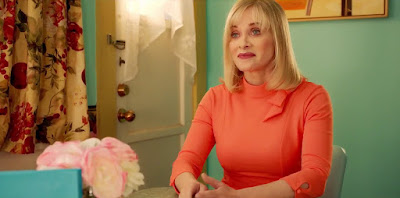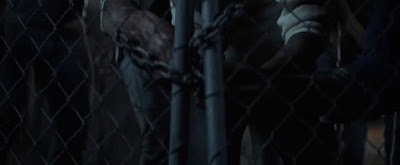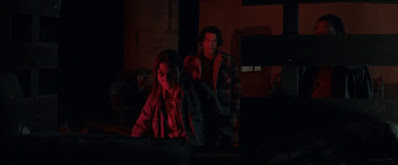
Hulu's series Into The Dark has received a...mixed reception to say the least. While the series has its fans (including myself, if my Pride Month post on the "Midnight Kiss" episode didn't make that clear), there are also several detractors whom dislike the series for varying reasons, including the varying quality of the episodes as well as the frequent attempts to infuse political/social commentary (something I touched upon in last week's hot take post). There is one episode, however, that many, including myself, have singled out as being if not the best than one of the more successful of the bunch: "Culture Shock."
"Culture Shock" follows Marisol (Martha Higareda), whom desperately wants to leave her native Mexico behind her to go to America. After one failed attempt to illegally cross the border that results in a sexual assault and pregnancy by the man she was set to enter America with, Oscar (Felipe de Lara), Marisol is ready to try again. She pays for her way to America, meeting others along the way including enigmatic Santo (Richard Cabral) and young Ricky (Ian Inigo). After encounters with the cartel and US Border Patrol, Marisol eventually wakes up in America, greeted by the ever chipper Betty (Barbara Crampton). Despite it being everything she could have wanted, Marisol soon finds that there's something far more twisted at play. While there are many components that make "Culture Shock" one of the best Into The Dark episodes, I think that one of the most prominent is the choices in aesthetics made by the episode's director and co-writer, Gigi Saul Guerrero, in which she splits the episode into three separate aesthetics to reflect the headspace and journey of her protagonist.

Marisol (Martha Higareda), protagonist of "Culture Shock"
Guerrero, along with cinematographer Byron Werner, split "Culture Shock" into three separate aesthetics, with the first being what we see throughout the first act of the episode. The first act follows Marisol in Mexico on her journey towards America, and, as a result of her determination to leave one country for another, the aesthetic for Mexico is purposefully presented as extremely bleak. In many scenes, the colors have been mostly drained of any sort of life and vividness, very often showing only grays and whites.







The bleakness of act one of "Culture Shock"
However, even with the bleakness, there are still a few colors to be found: To reflect Marisol's goal of getting to America, Guerrero and Werner subtly place varying objects and lights with the colors of red, white and blue to reflect how seeped the desire is into Marisol's mind. It's a want so deep, it comes out even subconsciously in her clothes, as one of Marisol's pieces of clothing is a red, white and blue flannel shirt.

This comes to a head at the end of the first act, in which Marisol is found out by the cartel and she and Ricky have to make a run for it. They are forced into darkness, with the exception of the white lights from various sources. But, then, when Border Patrol catches Marisol? That's when we fade to black, and transition to the second act, which is the visual opposite of the first.





Act one's conclusion
When asked about her inspiration for the bright, cheery, candy-like palette for the second act, Guerrero explained on her Twitter that she wanted to create something that could recreate the experience in a visual manner of someone being forced into a new culture completely removed from their original culture. Which does come across, especially as Marisol and the other Latinx characters are both far enough removed from their native culture and insidiously erased of their culture that, among other details, they speak English instead of Spanish. Guerrero also stated in a couple of tweets that her compass for how she wanted the second act of "Culture Shock" to appear came from old timey American propaganda artwork.




Also of note is that while red, white and blue are very much still a part of the color palette, other colors (primarily green, but also yellow and purple) have been added in. Keep an eye on the use of the color green, as it will come into play later.










The insidious beauty of America in "Culture Shock"
Another visual aspect to note is the scenes of characters eating. It's an element that's also present in Guerrero's prior short film El Gigante (available for viewing on Shudder) and certainly adds to the horror vibes she is trying to convey, as well as being a visual metaphor for, to paraphrase Guerrero, literally shoving a new culture down your throat.






Food horror in "Culture Shock"
Finally, I want to highlight the choice of wardrobe worn by the character of Thomas (Shawn Ashmore). While his wardrobe does include color, especially blue and red, his style is considerably muted compared to his surroundings. That's to foreshadow the reveal coming about his character, as well as the nature of where exactly Marisol and the others have ended up.


Shawn Ashmore as Thomas, friend or foe?
Which leads us to act three: Where the aesthetics from the first two acts are used, as well as a third aesthetic for the lab where the American government has put Marisol and the others. Interestingly, a very murky green color is used for the lighting in most of the lab scenes. Guerrero was asked about the choice for the lab's look on Twitter, and responded with a mix of films that served as an influence: Overlord, Hostel and The Matrix. While I haven't seen Overlord and can't comment on its influence, it can definitely be seen that Hostel and The Matrix are influences.


In addition to the above influences, I think that another reading of the gradual expansion of green in "Culture Shock"'s color palette can be rooted back into Marisol's headspace: With her growing realization at what America has done and is doing to her and her body, along with the others like Santo, she begins to realize America isn't as preferable to Mexico as she believed it would be. And so, as the colors of the American flag bled in through the first half of the episode, the colors of Mexican flag (red, white and green) begin to gradually flood through until the climax, in which we get those colors in abundance as Marisol, Santo and the other Latinx travelers fight their way out of the lab.
In the end, though, Marisol and the group escape from the lab and we revert back to the bleakness from the first act for the most part, with some color provided by the fireworks. It should be noted, though, that despite the aesthetic being dark once more, that this is not an unhappy ending for Marisol. Although she no longer wants to go to America, she has decided to return to Mexico and face her conflicts head on. While it's sad that she and Santo must split, as he assures her that he can't return home with her, it's still a hopeful ending. Showing us that, even in the darkness, we can still figure out a way to see the lighter side of things.




Combine that with the haunting use of the song "Y Volveré" by Los Angeles Negros, and you have a solid conclusion to one of the best installments of Into The Dark yet...
























No comments:
Post a Comment